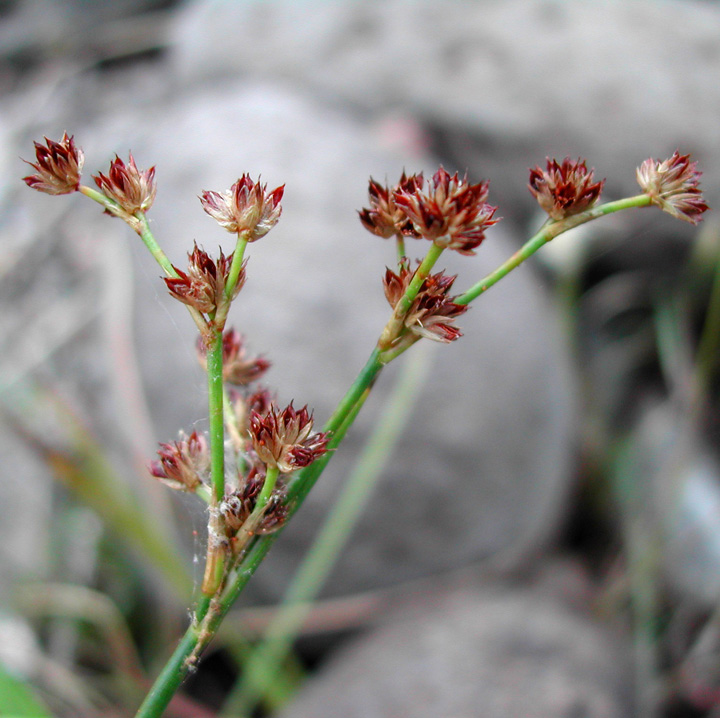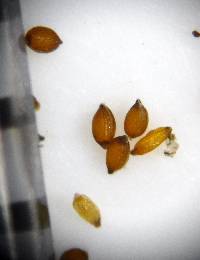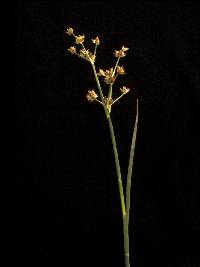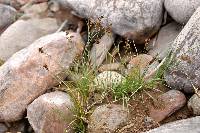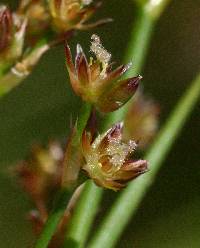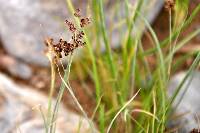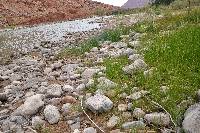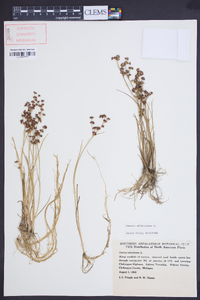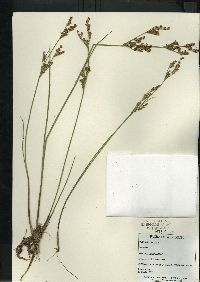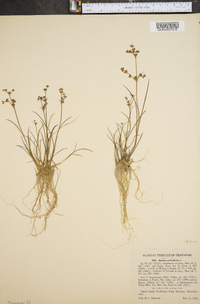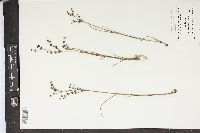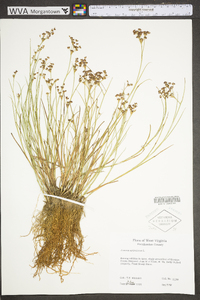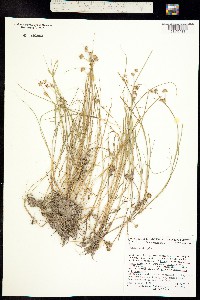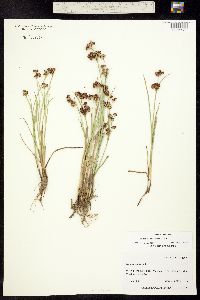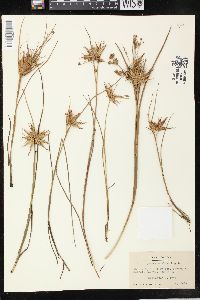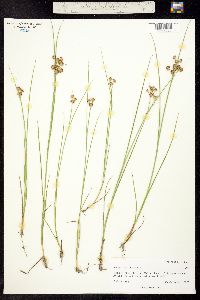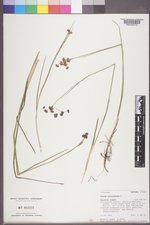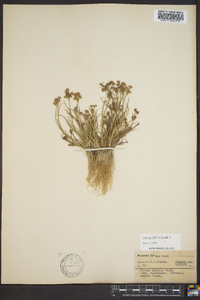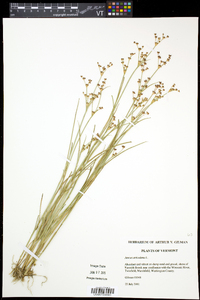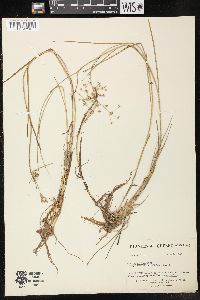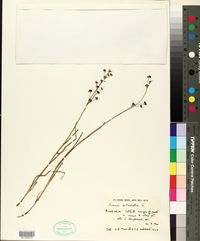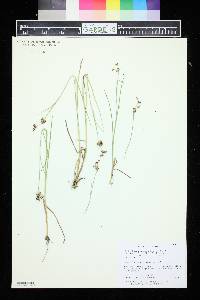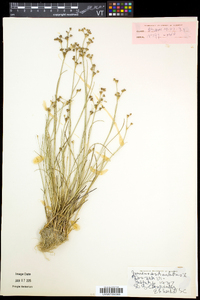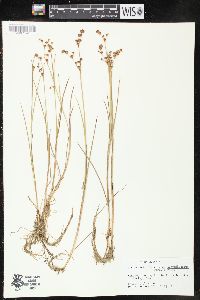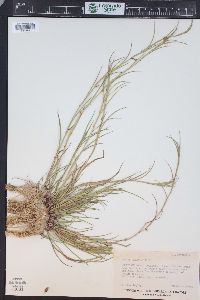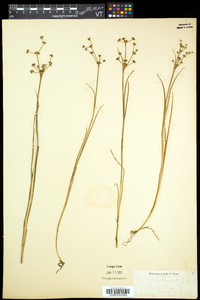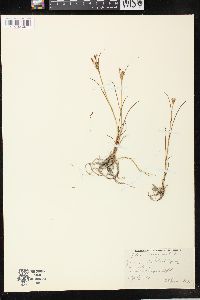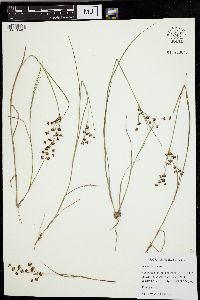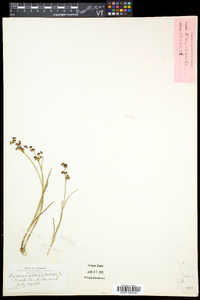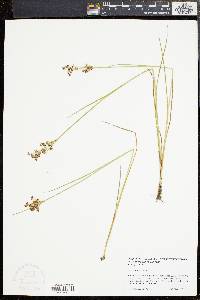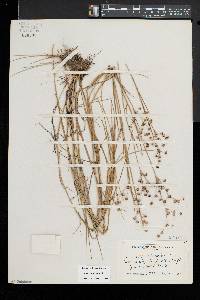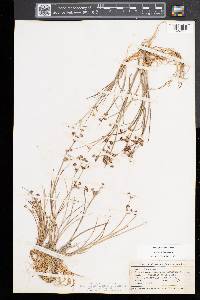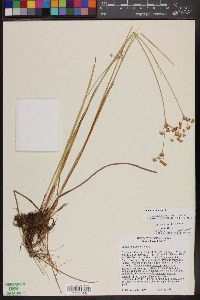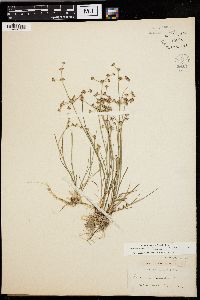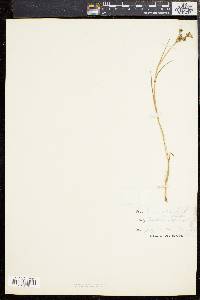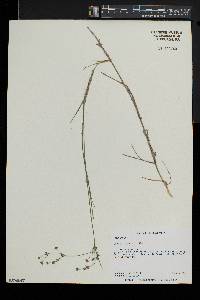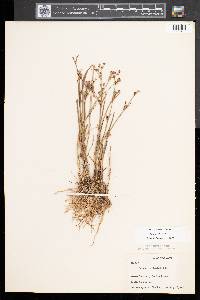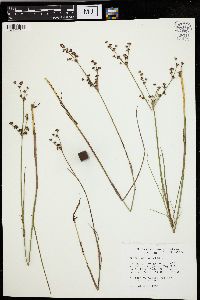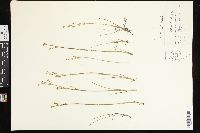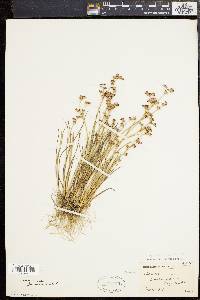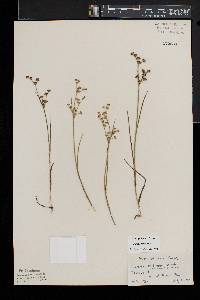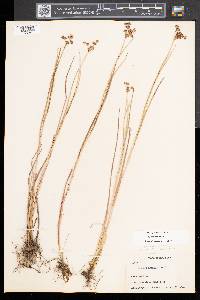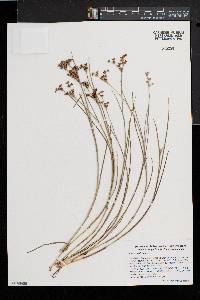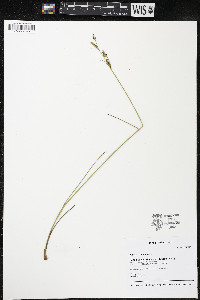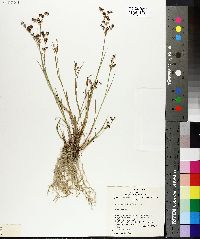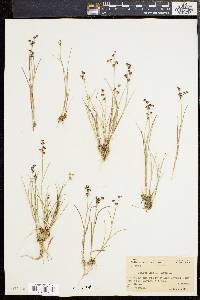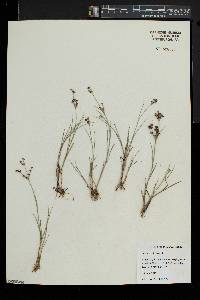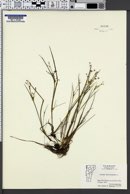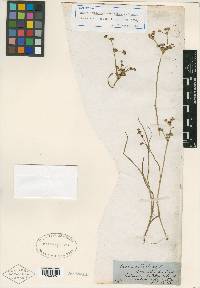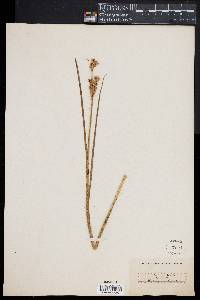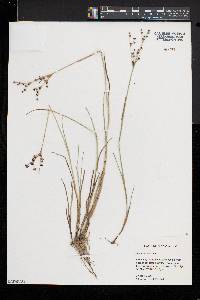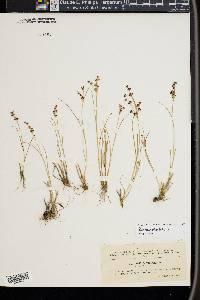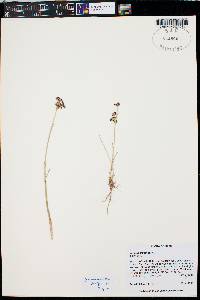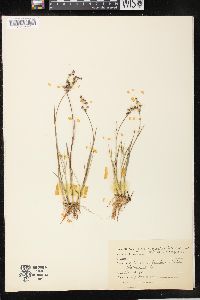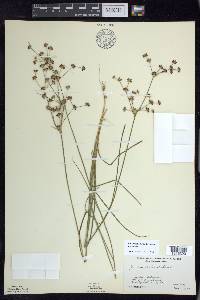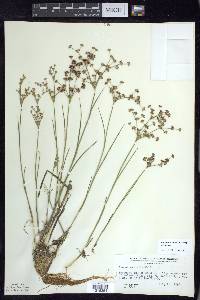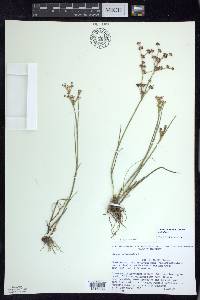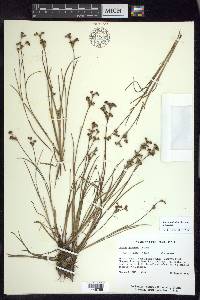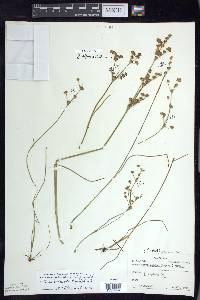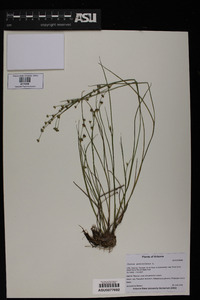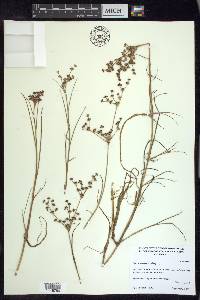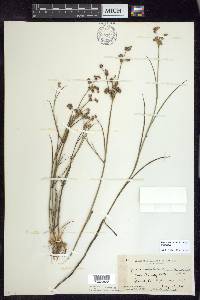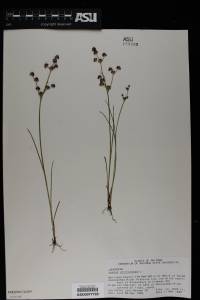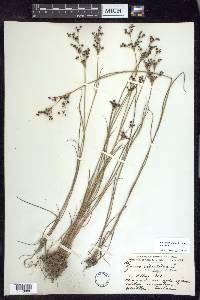Juncus articulatus
|
|
|
|
Family: Juncaceae
Joint-Leaf Rush, more...jointleaf rush, jointed rush
[Juncus articulatus var. obtusatus Engelm., moreLuzula hyperborea var. latifolia (Kjellm.) B. Boivin] |
Herbs, perennial, rhizomatous to nearly cespitose, 0.5--6(--10) dm. Rhizomes 2--3 mm diam., not swollen. Culms erect to decumbent (and floating), terete, 1--3 mm diam., smooth. Cataphylls 1, maroon to straw-colored, apex acute to obtuse. Leaves: basal 0--2, cauline (1--)3--6; auricles 0.5--1 mm, apex rounded, scarious; blade green to straw-colored, terete, 3.5--12 cm x 0.5--1.1 mm. Inflorescences terminal panicles of 3--30(--50) heads, 3.5--8 cm, branches spreading; primary bract erect; heads 3--10-flowered, obpyramidal to hemispheric, 6--8 mm diam. Flowers: tepals green to straw-colored or dark brown, ovate to lanceolate, 1.8--3 mm; outer tepals with apex acute or acuminate; inner tepals with apex acute acuminate to obtuse; stamens 6, anthers equal to filament length. Capsules exserted ca. 1 mm beyond perianth, chestnut brown to dark brown, imperfectly 3-locular, ellipsoid or ovoid, 2.8--4 mm, apex acute proximal to beak, valves separating at dehiscence. Seeds obovoid, 0.5 mm, not tailed. 2n = 80. Fruiting mid summer--fall. Wet ground in ditches, lake and stream margins, and a variety of other habitats, often a calciphile; 0--3000 m; St. Pierre and Miquelon; B.C., N.B., Nfld. and Labr. (Nfld.), N.S., Ont., Que., P.E.I.; Alaska, Ariz., Colo., Calif., Conn., Idaho, Ind., Ky., Maine, Mass., Mich., Minn., Nebr., Nev., N.H., N.J., N.Mex., N.Y., N.C., Ohio, Oreg., Pa., R.I., S.Dak., Utah, Vt., Va., Wash., W.Va.; Eurasia. Juncus articulatus hybridizes with J. brevicaudatus (= J. ´ xfulvescens Fernald), J. alpinus (= J. ´ xalpiniformis Fernald), J. nodosus, and J. canadensis. Juncus articulatus var. obtusatus Engelmann appears to be intermediate with J. alpinus. It has spreading inflorescence branches but obtuse inner tepals. This may represent a backcross with J. alpinus. Recent evidence suggests that J. alpinus is a polyploid species with J. articulatus as one of its parents.
Perennial grasslike forb 5 - 80 cm tall Leaves: none to two basal and two to six alternate on stem, green to straw-colored, 3.5 - 12 cm long, 0.5 - 1.1 mm diameter, linear, grasslike, round in cross section, and with distinct crosswise partitions inside (septate). The leaves also have a thin and papery, basal, 0.5 - 1 mm long, round-tipped, ear-like appendage (auricle) at the top of the leaf sheath. Inflorescence: a terminal, 3.5 - 8 cm long, spreading-branched structure with branches ending in three to fifty, inversely pyramidal or hemispheric, 6 - 8 mm diameter flower clusters. Each flower cluster is a compact head of three to ten, tiny, radially symmetric flowers. Stamens: six, with filaments and anthers about same length. Pistil: with one superior ovary, and three stigmas. Fruit: somewhat three-chambered, chestnut-brown to dark brown, 2. 8 - 4 mm tall (taller than tepals by about 1 mm), ellipsoid or egg-shaped, tapering pointed-tipped capsules which open down the sides. Stems: sometimes appearing tufted, erect or decumbent, smooth, round in cross section, 1 - 3 mm diameter, and arising from 2 - 3 mm diameter rhizomes lacking swollen nodes. Seeds: many, clear yellow-brown, 0.5 mm long, inversely egg-shaped with short-pointed or abruptly narrowed tips, but without distinct narrowed tails at the ends. Tepals: six in two whorls of three, green to straw-colored or dark brown, 1.8 - 3 mm long, egg- to lance-shaped usually with pointed tips. All six of the tepals are about the same length, though the inner three (which can be round-tipped) are sometimes a bit longer than the always pointed-tipped outer tepals. Similar species: Juncus articulatus is most similar to J. alpinoarticulatus, but that species always has the inner three tepals blunt with rounded tips, and the inflorescence is less spreading and more narrow in appearance. The hybrid between these two species, J. x alpiniformis, is also incredibly similar, but it too has more erect or ascending inflorescence branches. Flowering: July to September Habitat and ecology: Rare, but occasionally seen in sandy calcareous soils in the eastern part of the Chicago Region. Occurence in the Chicago region: native Notes: Juncus articulatus hybridizes with several species within its subgenus (Septati), including J. alpinoarticulatus, J. brevicaudatus, J. nodosus, and J. canadensis. Author: The Field Museum Stems usually erect, rather closely set on a coarse rhizome, 1-6 dm, with chiefly cauline lvs, these 2-4, the blade mostly 2-15 cm נ0.7-1.5 mm, terete, aerenchymatously hollow, septate-nodulose; infl broadly ovoid to depressed, with divergent to widely ascending branches, up to nearly twice as long as wide, with few to many obpyramidal to subhemispheric, 3-10-ld glomerules; fls eprophyllate; tep lanceolate to lance-subulate, (2-)2.5-3 mm, subequal (or the pet a bit longer than the sep), the sep acute to subacuminate, the pet more often obtuse; stamens 6; fr unilocular, chestnut-brown to purple-brown, exsert, sharply ovoid-trigonous, tapering in the distal half, 2.5-4 mm, acute or seldom obtuse below the mucronate tip; seeds 0.5 mm; 2n=80. Bogs, wet meadows, and shores; circumboreal, s. in our range to R.I., W.Va., s. O., n. Ind., and Minn. A form with creeping stems, rooting at the nodes is rarely found. Gleason, Henry A. & Cronquist, Arthur J. 1991. Manual of vascular plants of northeastern United States and adjacent Canada. lxxv + 910 pp. ©The New York Botanical Garden. All rights reserved. Used by permission. From Flora of Indiana (1940) by Charles C. Deam Known in Indiana from a single collection: on an abandoned road through a marsh on the southeast side of Lake Wawasee, Kosciusko County, Deam no. 56408, July 19, 1935. Here it was abundant in 1935. Specimens could not be located to corroborate the reports from Lake County made by Coulter, Deam, Peattie, and Pepoon. …… Indiana Coefficient of Conservatism: C = 4 Wetland Indicator Status: OBL |

